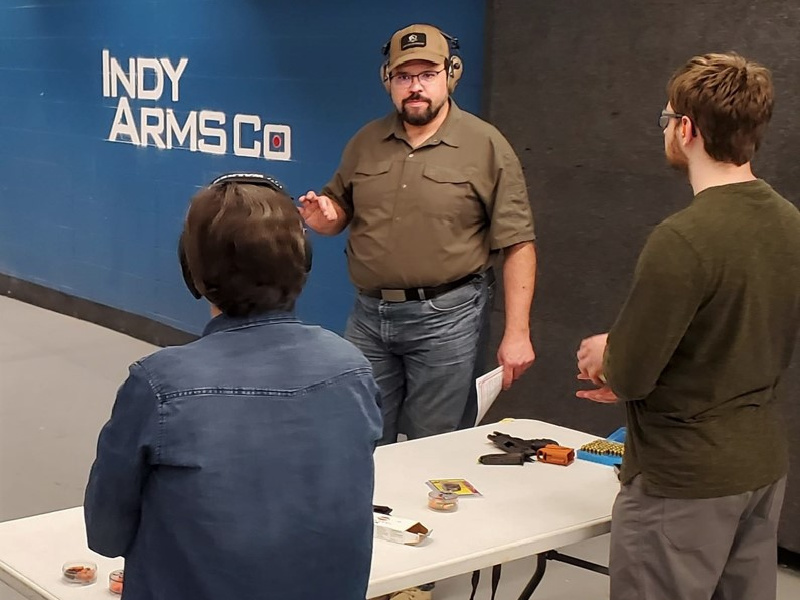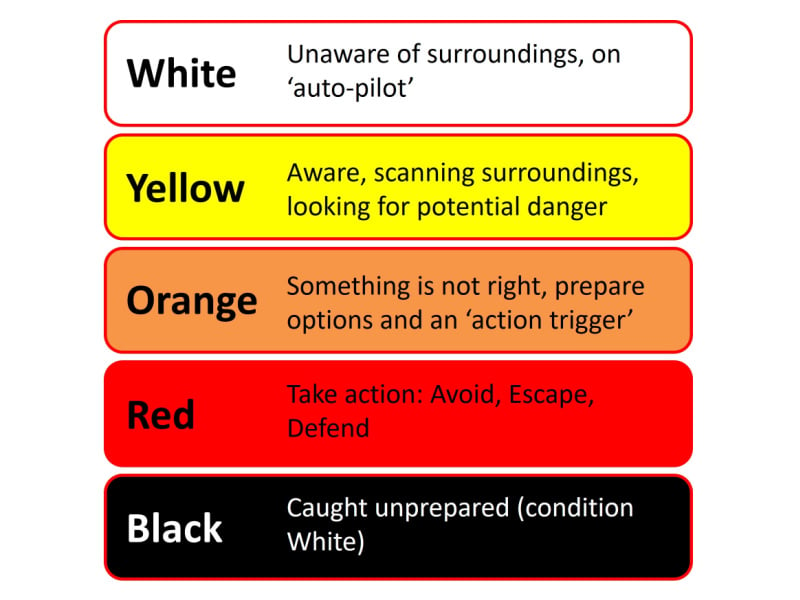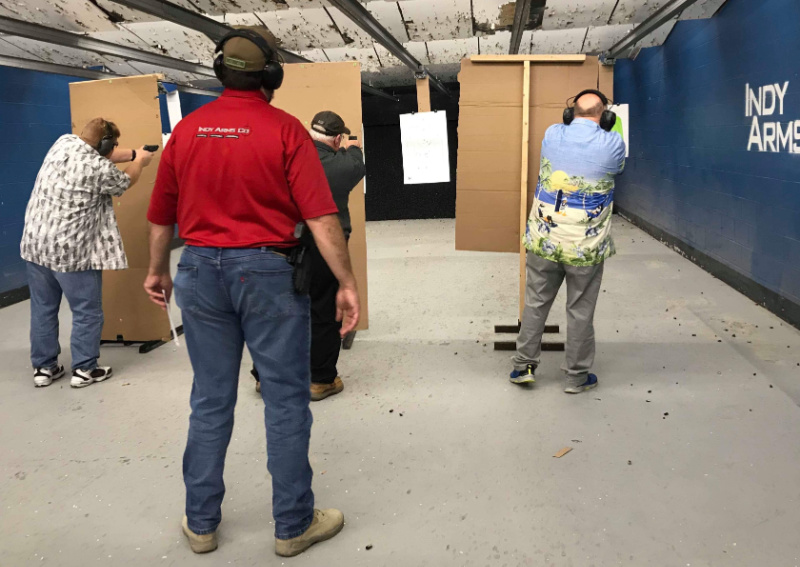Civilian self-defense is a complex combination of personal traits (what you think you are willing to do), ability (what tools and training you have), legal concerns (what the law says), risks (likelihood of events), and consequences (survival and legal outcomes). Within this combination, there are rarely absolutes. Behaviors that result in a successful survival and legal outcome in one situation may have a very different outcome elsewhere. I draw attention to the “reasonable person” test that resides in some form in all U.S. self-defense laws. One of the impacts of this phrase is, no matter how well-written the law in all other areas, it boils down to whether a jury agrees with the defendant’s or prosecutor’s side. Ambiguity tends to breed complexity. From this complexity, few instructors disagree the best way to succeed in a self-defense encounter is to never have encounter in the first place. Another result of complexity is to use simple models, like Avoid/Escape/Defend, to navigate civilian self-defense.

I often utilize the Avoid/Escape/Defend model in my classes. This model is a framework for categorizing skills and training while serving as a reminder of behaviors to implement. I’ve seen various versions with small tweaks of this concept in many national and local training programs. Additionally, this model is echoed in most mass shooting response training with the Run/Hide/Fight model.

Definition of Avoid/Escape/Defend
In its simplest form, the Avoid/Escape/Defend model defines what can be done sequentially in response to potentially needing to protect ourselves and loved ones.
Avoid is all the behaviors that can be done to never encounter a dangerous situation in the first place. This can include preventative measures, tools, and choices designed to minimize risks. Skills include making decisions that communicate you are a poor victim for potential crimes and recognizing and avoiding risky situations.
Escape is the next step when Avoid fails. If we find ourselves in a potentially dangerous or risky situation, leaving, if safe, should be our next option. Escape includes skills such as situational and environmental awareness and a quick escape plan ready, if needed. A guiding principle of Escape is the adage, “The best way to win a gunfight is to never be in one”.
Defend should only be an option when avoidance has failed and safely escaping is not an option. Defending implies we can communicate our willingness to use force or, if needed, use it. Clear communication, conflict de-escalation, and determined resistance (intimidation) should be included with fundamental, mechanical, and tactical firearms skills.
Using Avoid/Escape/Defend to Define Training
I often reflect on the importance of each level of the Avoid/Escape/Defend model and the inverse nature of most training. Avoidance behaviors are likely the most important in preventing the need to move forward to the next two levels in the first place. If Avoid fails, many situations can likely be escaped safely with situational and environmental awareness. This leaves Defend as a worst case scenario option to only be used if Avoid and Escape have failed. In contrast to this, most self-defense training classes may discuss Avoid and Escape, but are primarily focused on Defend. This likely is a result of what easily comes to mind (a defensive scenario) and is more active and engaging to train in (defensive skills).
I am unaware of any program of instruction that doesn’t fall prey to this including the ones I have designed. At Indy Arms, we have two classes focused on Avoid: Taking Charge (formerly NRA’s Refuse to be a Victim) and Emergency Preparation. We have a few classes more focused on escape (but still mixed with defense) in our Weapon Retention and Pepper Spray/Taser class. Although all our classes have a slide or two on Avoid and Escape, the remainder of our handgun classes (over 10) focus on Defend.
The disparity will likely continue between courses offered and skills we need to build. However, the Avoid/Escape/Defend model can make sure we are practicing these skills in our own lives. We should seek out classes that focus on us avoiding being targeted in the first place. We should develop our awareness skills. This increases the chance we can safely escape a developing situation by recognizing it earlier. Once we haven’t neglected these two important skill sets; then learn everything you can if Defend is the only option.

Avoid
I look at the idea of Avoid as all you can do to make Escape and Defend unnecessary. Avoid is three groups of behaviors: hardening your home and vehicle, avoiding dangerous areas, and projecting confidence.
Hardening your home (and vehicle) includes making sure criminals are unlikely to target your home in the first place. This includes adding security, cameras, locking entrances so they aren’t an easy entry method, and having your property well-lit. It’s surprising how much theft occurs with no breaking, only entering, through unlocked doors. Thus, one of the simplest methods is to make sure to always lock your home and vehicle’s doors.
Second, avoid dangerous areas and situations. I once was told in a defensive class “don’t hang out with stupid people, don’t do stupid things, don’t go to stupid places, and be in bed before midnight (stupidity increases greatly the later the time)”. Many people interpret this as a day-to-day process of staying in safer areas. It’s also worth checking the crime rates (especially breaking and entering) when planning a move. I’ve passed on nicer houses and apartments over the years because they were also in a higher crime area.
The final behaviors revolve around projecting confidence. Criminals have reported in multiple FBI interviews that they look for likely targets based on body language and, especially, awareness. Projecting fear and uneasiness with downcast eyes (or lost in a cell phone) is much more likely to be targeted than someone walking with confidence and eyes up taking in their surroundings.

Escape
Escape is a function of situational awareness (awareness of the people and potential threats around you), environmental awareness (awareness of the location you are at including the best avenues of escape if needed), and having a plan to implement if needing to escape.
Situational awareness is the being aware of the people and threats in your immediate area. This is represented by color codes: white (unaware), yellow (eyes up and alert), orange (noticing a potential threat) and red (acting on that perceived threat, generally escape or defend).
I separate environmental awareness from situational awareness. The focus is less about threats than it is advantages your current location offers (lines of sight, potential cover or concealment, and best paths of escape). Safely escaping should generally be our first option by utilizing the information of a potential threat (situational awareness) and the best way to safely escape (environmental awareness). This primarily involves a quick and easy plan for most common situations allowing you to quickly enact escape if needed. A final note, escape often involves others and quick and easily understood pre-planned communications will assist you in such efforts.

Defend
We hope this last option is not needed. If we’ve devoted resources and skills to Avoid and Escape, it often will not be. However, no matter what steps taken in avoiding and preparing to escape, Defend may still be needed. We cannot control every variable and some crime is truly random.
Make no mistake, I strongly encourage everyone to develop their defensive skill sets. I openly admit I spend a disproportionate amount of time training for this possibility compared to practicing Avoid and Escape. However, any good self-defense plan must accept that defensive action, including the use of force, represents a failure of the first two and more important steps.


